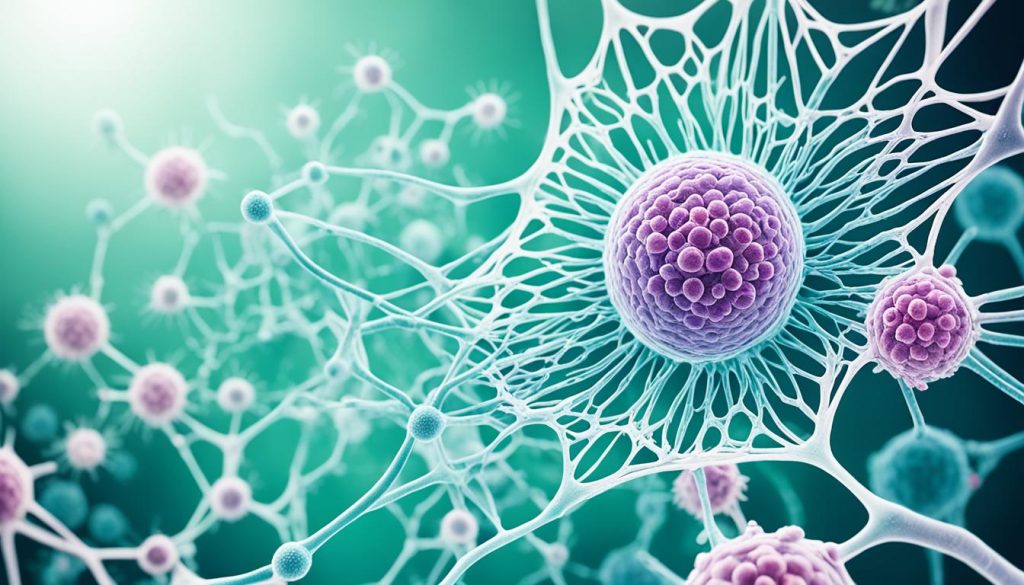Behcet’s disease, also known as Behcet’s syndrome, involves inflammation of blood vessels throughout the body. It leads to numerous symptoms, affecting the skin, eyes, and more. Experts believe it might be an autoimmune issue, though they’re not sure why it happens.
Young adults, especially in their 20s and 30s, often face this disease. Men typically have more intense symptoms than women. It’s more common in the Middle East, Asia, and certain areas of the West.
Behcet’s shows symptoms in cycles, with periods of improvement followed by flare-ups. While no cure exists, treatment can help manage its symptoms and reduce the risk of complications.
Key Takeaways:
- Behcet’s disease is an auto-inflammatory systemic vasculitis with unknown causes.
- It primarily affects young adults in their 20s and 30s, with men typically having more severe symptoms.
- Common symptoms include oral ulcers, genital ulcers, skin sores, eye inflammation, joint pain, gastrointestinal symptoms, and neurological symptoms.
- The exact cause of Behcet’s disease is unknown, but genetic and environmental factors may play a role.
- Diagnosis is based on medical history, physical examination, and symptom evaluation.
- Treatment aims to manage symptoms and prevent complications through medications, topical therapies, and lifestyle choices.
- Stem cell therapy may be considered as a potential treatment option.
Symptoms of Behcet’s Disease
Behcet’s disease comes with many symptoms that affect various parts of the body. These symptoms can change in how severe they are. They may not always be present. Each person with Behcet’s disease might have different symptoms. And, these can vary a lot from one person to another.
Common Symptoms of Behcet’s Disease:
- Oral ulcers: The first signs of Behcet’s disease are often mouth sores. These sores can hurt, come back often, and last for weeks.
- Genital ulcers: A lot of people with Behcet’s disease get genital ulcers. These sores can be painful and may lead to scarring.
- Skin sores: The disease can cause different skin sores like nodules, spots like acne, and erythema nodosum. These sores might hurt and leave scars.
- Eye inflammation: A common issue is uveitis, an eye inflammation. It may make your vision blurry, cause eye pain, make light bothersome, and even lead to loss of sight if not treated.
- Joint pain and swelling: Behcet’s disease often affects the joints too. This leads to pain, swelling, and stiffness, mostly in the knees, ankles, wrists, or elbows.
- Gastrointestinal symptoms: Some may have issues like belly pain, diarrhea, and sometimes bleeding in their guts.
- Neurological symptoms: The disease can also impact the brain and nerves, causing headaches, confusion, problems with memory, and symptoms like those of a stroke.
If you’re facing any of these problems, it’s key to see a doctor. They can figure out if you have Behcet’s disease and help you manage it.
| Symptom | Description |
|---|---|
| Oral ulcers | Mouth sores that are painful, recurrent, and can last for several weeks |
| Genital ulcers | Ulcers in the genital area that may cause discomfort, pain, and scarring |
| Skin sores | Various types of skin sores, including nodules, acne-like lesions, and erythema nodosum |
| Eye inflammation | Inflammation of the eyes, leading to blurry vision, eye pain, sensitivity to light, and potential vision loss |
| Joint pain and swelling | Pain, swelling, and stiffness in the joints, particularly the knees, ankles, wrists, or elbows |
| Gastrointestinal symptoms | Abdominal pain, diarrhea, and occasionally gastrointestinal bleeding |
| Neurological symptoms | Headaches, confusion, memory loss, and stroke-like symptoms |
Causes and Risk Factors of Behcet’s Disease
Behcet’s disease is not straightforward, as its exact cause remains unknown. However, it seems to be linked to both genetic and environmental factors. People from the Middle East, Asia, and some Western countries seem to have a higher chance of getting it.
There seems to be a genetic link to Behcet’s disease since it often occurs in families. For instance, having the HLA-B51 gene can increase your risk of developing the disease.
Environmental factors and certain triggers could also lead to Behcet’s disease. It looks like infections or contact with specific bacteria or viruses might start the disease. Scientists are doing more studies to find out which environmental factors are important.
Knowing what causes Behcet’s disease and who is at risk is key for early detection and treatment. This knowledge helps doctors care for people who might get the disease by watching their symptoms closely and picking the right treatments.
Ethnic Groups at Risk
Research shows that some ethnic groups are more likely to get Behcet’s disease. This includes people from the Middle East, like Turkey, Iran, and Iraq. People from Asia, especially Japan and Korea, are also at higher risk. Even in Western countries like the USA and the UK, there are cases.
The increased risk among certain ethnic groups might come from genetic and environmental factors working together. But scientists are still trying to understand the full picture.
Genetic Factors and Behcet’s Disease
Genes play a big role in Behcet’s disease. For example, the HLA-B51 gene can make you more likely to get the disease.
This gene affects how your immune system handles inflammation. If you have it, your immune system might react too strongly, causing Behcet’s symptoms.
Having the HLA-B51 gene doesn’t mean you will definitely get Behcet’s disease. But it is a clue that can help doctors diagnose and manage the disease together with other symptoms.
In summary, Behcet’s disease involves both our genes and our environment. Certain people are more at risk because of their ethnic background and specific genetic factors. Researchers continue to study this disease to find better ways to diagnose and treat it in the future.
Diagnosis of Behcet’s Disease
Diagnosing Behcet’s disease is tricky. There’s no single test that says for sure you have it. Doctors look at your medical history, check your symptoms, and give you a physical exam.
The International Criteria for Behcet’s Disease is a key tool for diagnosis. It helps doctors decide if your symptoms match Behcet’s disease.
Doctors might do more tests to rule out other causes for your symptoms. These can include:
- Blood tests: to check for inflammation and other conditions
- Eye examinations: to look for eye inflammation
- Skin biopsies: to check skin sores closely
- Imaging studies: such as X-rays and MRI, to see if organs or blood vessels are affected
If you think you might have Behcet’s disease, see a doctor familiar with it. Getting the right diagnosis is key to managing the disease well.
| Diagnostic Criteria | Description |
|---|---|
| International Criteria for Behcet’s Disease (ICBD) | A set of clinical criteria used to aid in the diagnosis of Behcet’s disease. These criteria include specific manifestations such as recurrent oral ulcers, recurrent genital ulcers, eye involvement, and skin manifestations. |
| Japanese Criteria for Behcet’s Disease | A set of diagnostic criteria specific to Behcet’s disease used in Japan. These criteria include a combination of clinical symptoms and laboratory findings. |
| International Study Group (ISG) Criteria | An older set of diagnostic criteria used to help identify Behcet’s disease. These criteria include a combination of clinical symptoms such as oral ulcers, genital ulcers, and eye involvement. |
Several criteria help in diagnosing Behcet’s disease. Which criteria doctors use can depend on their experience and your symptoms. Always consult a healthcare professional who knows about Behcet’s for the best advice and care.
Treatment and Management of Behcet’s Disease
Behcet’s disease can’t be cured yet, but doctors aim to lessen symptoms and avoid worse issues. Treatment is tailored to each person based on their disease’s severity and symptoms.
Drug therapies: Medicines like corticosteroids, immunosuppressants, and biologic agents are key in treating Behcet’s disease. Corticosteroids fight inflammation and are great for quick symptom relief. If corticosteroids don’t work well enough, drugs like azathioprine or methotrexate might be used. Biologic agents focus on specific parts of the inflammation process.
Topical therapy: For sores in the mouth or on the skin, topical treatments are applied directly. Oral ulcers might get better with corticosteroid rinses or creams. Skin sores can also be treated with corticosteroid creams to ease pain and speed up healing.
Oral therapy: Severe Behcet’s disease or cases not improved by topical treatments may require pills. Pills like colchicine or dapsone calm the immune system and lower inflammation. They’re often used with other therapies for better results.
Lifestyle choices: Managing Behcet’s disease also involves lifestyle changes. Enough rest and sleep combat fatigue. Exercise, adjusted for each person, boosts heart health and keeps muscles strong. Eating well is crucial too, with lots of fruits, veggies, grains, and protein. Working with doctors to tailor a treatment and lifestyle plan is essential.
| Treatment Approaches | Description |
|---|---|
| Drug therapies | Corticosteroids, immunosuppressants, and biological therapies are used to reduce inflammation and manage symptoms. |
| Topical therapy | Corticosteroid rinses or ointments can be used to treat mouth and skin sores locally. |
| Oral therapy | Systemic medications are prescribed for more severe cases or when topical therapies are not sufficient. |
| Lifestyle choices | Rest, exercise, and a healthy diet can support symptom management and overall well-being. |

Conclusion
Behcet’s disease is a tricky autoimmune disorder that reaches many parts of the body. While no cure exists yet, managing it is very possible with the right treatments and lifestyle. The main treatment goals are to lessen inflammation, ease symptoms, and avoid complications.
Treatments include drugs like corticosteroids and immunosuppressants, as well as biologics. These meds work to calm the immune system and reduce swelling. Along with medication, living a healthy lifestyle helps too. This means exercising regularly, getting enough rest, and eating well.
Lately, stem cell therapy has been looked at as a new way to treat Behcet’s disease. It’s an exciting idea, but we need more studies to be sure it’s safe and works well. People with the disease should talk closely with their doctors to create a plan that fits their needs.
To live well with Behcet’s disease, staying informed and working with your healthcare team is crucial. By doing so, people with Behcet’s can have a good quality of life and keep their symptoms in check.

